Transcription
PREVENTIVE DETENTION IN THE UNITED STATES:
Crime Fighting Weapon or Political Tool of the Right
The recent U.S. Supreme Court decision upholding the constitutionality of preventive detention laws has been viewed as a major victory for conservatives, and another in a series of setbacks for civil libertarians. For nearly two decades the primary goal of conservative crime control strategy has been to remove dangerous criminals from the streets, and it is anticipated that this ruling will facilitate the rapid incorporation of similar laws throughout the country. The effect that these laws will have upon crime is open to debate.
Preventive detention authorizes a judge to incarcerate accused criminals before trial if the individual is deemed dangerous to the community, and if the probability exists that the defendant will commit additional crimes when release on bail is granted. Its goal is to circumvent the longstanding principle that the sole purpose of bail is to guarantee the appearance of the accused at trial. In this study we will review the history of preventive detention in the United States, and based on studies from the cities of Washington, D.C. and Boston, Massachusetts, examine its use.
The call for preventive detention is directly related to the bail reform movement of the 1960's. Reformers perceived jails as poorhouses, since only people of low income were unable to raise bail money. Since confinement was not based on guilt or innocence, bail reformers attacked the system as discriminating against the poor. The culmination of this movement was the 1966 Federal Bail Reform Act, which directed the implementation of such non-monetary procedures as "release on recognizance". In rapid order, many states incorporated similar laws, and the percentage of defendants held in jail before trial dropped from 52 percent in 1967 to 38 percent in 1979.
No sooner were reforms in effect than opposition arose. Probably the most notable of the early proponents of preventive detention was the former Governor of Alabama, George Wallace, who cynically noted that criminals were released on bail before the victim was out of the hospital. A dramatic increase in crime occurred at this time. For example, in 1966 there were 5.6 murders for 100,000 people; in 1972, 9.41, and conservatives saw a connection between the two (Wilson, 1975: 15); they viewed bail reform as another liberal social experiment clearly harmful to society. In response, a special Judicial Council Committee was formed to examine the impact of the Bail Reform Act in the District of Columbia; their primary recommendation: the legalization of preventive detention. Their findings were forwarded to President Nixon, who endorsed the concept in 1969. Preventive detention became law in the District of Columbia in 1970.
The implementation of this law gives us the opportunity to examine the principle of preventive detention. To be held without bail, a person had to be charged with a crime of violence or a dangerous crime. A formal hearing is held to determine whether probability of guilt exists; additionally, the defendant must have been convicted of a crime during the previous 10 years, be a drug addict, or be on parole or probation. To ensure a degree of due process, the accused has a right to a speedy trial within 60 days of arrest; otherwise he/she will be released on bail.
With the law firmly in place, Georgetown University and the Vera Institute conducted a study to determine its effect during the law's first six months. Their findings were startling; of the 6,000 felony defendants brought before the bar, prosecutors filed but 20 detention motions, which resulted in eight detentions. Of these eight, five were reversed on appeal or reconsideration. A sixth was dismissed when the grand jury would not indict the suspect. Judicial initiative led to two additional detentions. All told, only four persons were detained through trial during the reported period. (Thomas, 1976: 231-2).
Preventive detention's surprising nonuse was simple to explain, and it had little to do with liberal judges. The law was not used because prosecutors simply did not need it. Since robbers, for example, have little or no money, merely setting bail at a level beyond their financial means would keep them effectively detained. Eisenstein and Jacob (1977: 200) discovered that the average bail for armed robbery was $7,719 in Chicago and $23,686 in Baltimore.
Therefore, rhetoric notwithstanding, preventive detention has traditionally been practiced by the American criminal justice system. Judges and prosecutors have always used high bail to detain those defendants they deemed dangerous despite the Eighth Amendment and the legal principle that the purpose of bail is to ensure the defendant's appearance at trial. In his study on bail setting practices in place before the 1966 Act, Frederic Suffet found a considerable degree of cooperation among judges, prosecutors and defense attorneys in setting high bails, with disagreements arising in only 12 percent of the cases. This practice was challenged but not entirely eliminated by the bail reform movement. (Suffet, 1966).
Much research has been conducted to determine how well felony defendants succeed in not reoffending while free on bail. Since preventive detention is invoked in the interest of public safety, the court's ability to predict reoffenses is crucial, and deserves further attention. One way in which the question of predictability might be investigated is to determine the frequency of felony arrests among defendants who are currently under release on bail. A 1970 study by the National Bureau of Standards indicates that approximately seven percent of persons released on bail after being charged with a felony were subsequently rearrested for another felony; however, there were marked variations (Thomas, 1976). Defendants charged with certain types of crime had particularly high failure rates. For example, individuals arrested for possession of illicit drugs were very likely to go out and use drugs right away - and be rearrested. On the other hand, there was an extremely low failure rate for sex offenders. The highest failure rate of any category observed was robbery; about 30 percent of all robbers freed on bail were rearrested for robbery. If we expand the rearrest record to include rearrest for any type of felony, robbers fail at a rate greater than 50 percent.
Society's commitment to the individual's right to release on bail is strongly tested based on these failure rates. Indeed, a conservative would view the figures as proof positive that a reduction in the crime rate could be accomplished by incarcerating the few dangerous offenders; however, even if this relationship were correct, the identification of potential recidivists is problematic. Predicting human behavior is an imprecise art; errors made in the name of preventive detention inflict a heavy burden upon the individual and society. Two mistakes can be made. First, defendants who in fact will not commit violent offenses while out on bail may be detained. Second, those who will commit violent crimes while out on bail may not be identified. We are faced with serious social costs in both cases. Incarcerating people unnecessarily imposes a tremendous financial cost on the defendants' family and society, since detaining the accused often relegates his family to the welfare roll, while the expense of building additional jail space falls upon the populace. On the other hand, failing to incarcerate the truly dangerous people means that many innocent citizens might be victimized.
Two independent studies of preventive detention have determined that only five percent of those defendants eligible for detention would be arrested for another violent offense while free on bail. A Boston study discovered that 5.2 percent of those originally arrested for a violent offense were rearrested for another violent crime, while the National Bureau of Standards study determined that five percent of those eligible for detention under the Washington, D.C. law were subsequently rearrested for another violent crime. It is quite clear that attempting to identify recidivists within the original group would be difficult, if not nearly impossible. The apparently simple solution to the problem is to detain all the defendants. The Boston study implied that 19 non-dangerous people would have to be detained in order to detain one dangerous person. The monetary costs of such a practice are clearly prohibitive, while the social costs of unnecessary incarceration is more difficult to establish. (Erwin, 1971).
Although many people believe that they can identify dangerous repeat offenders, in practice, we simply lack the ability to determine who is dangerous and who is not. The District of Columbia bail agency examined the detention records of two judges of the District of Columbia Court of General Sessions to ascertain their ability to spot potential repeat offenders. Judge Halleck detained 51 percent of 200 defendants before him, while Judge Alexander detained only 20 percent of his defendants. The rearrest record for those defendants released on bail was strikingly similar; eight percent for Judge Halleck, and nine percent for Judge Alexander. It is clear that Judge Halleck's ability to identify dangerous repeat offenders was no better than Judge Alexander's, although he detained 2.5 times as many defendants (Thomas, 1976: 239-40).
Preventive detention has shown itself to be a problematic policy, pleasing neither politicians on the right or left. It has failed to be the panacea for crime control that conservatives perceived it to be, while liberals view it as a further erosion of the rights of the individual in American society. The irreconcilable differences of opinion about this issue were clearly elucidated in the U.S. Supreme Court's decision. Writing for the conservative majority, Chief Justice William H. Rehnquist stated "when the government proves... that an arrestee presents an... articulable threat", a court "may disable" the defendant. He concluded that jailing a defendant was not punishment, but merely congressional "regulation" (U.S. v. Salerno, 107 S. Ct. 2095, 1987). In a strident dissent, Justice John Paul Stevens argued, according to that reasoning, why should "dangerous" defendants be released, even if acquitted? Surely, "it is unrealistic to assume that the danger will vanish if a jury happens to acquit them".
REFERENCES:
Eisenstein, J. and Jacob, H. (1977) Felony Justice. Boston: Little, Brown
Erwin, S.J. (March, 1971) "Preventive Detention: An Empirical Analysis" Harvard Civil Rights - Civil Liberties Review, 6:3, 289-396.
Suffet, F. (1966) "Bail Setting: A Study in Courtroom Interaction", Crime and Delinquency, 12:3, 318-31.
Thomas, W.H. (1976) Bail Reform in America. Berkeley: University of California Press.
Wilson, J.Q. (1975) Thinking About Crime. New York: Basic Books
(This article originally appeared in the Journal of Prisoners on Prisons, Vol. 2, No. 1, Fall 1989.)
Other posts by this author
|
2020 jul 25

|
2017 aug 4

|
2016 oct 4

|
2016 aug 13

|
2016 may 8

|
2016 may 4

|
More... |

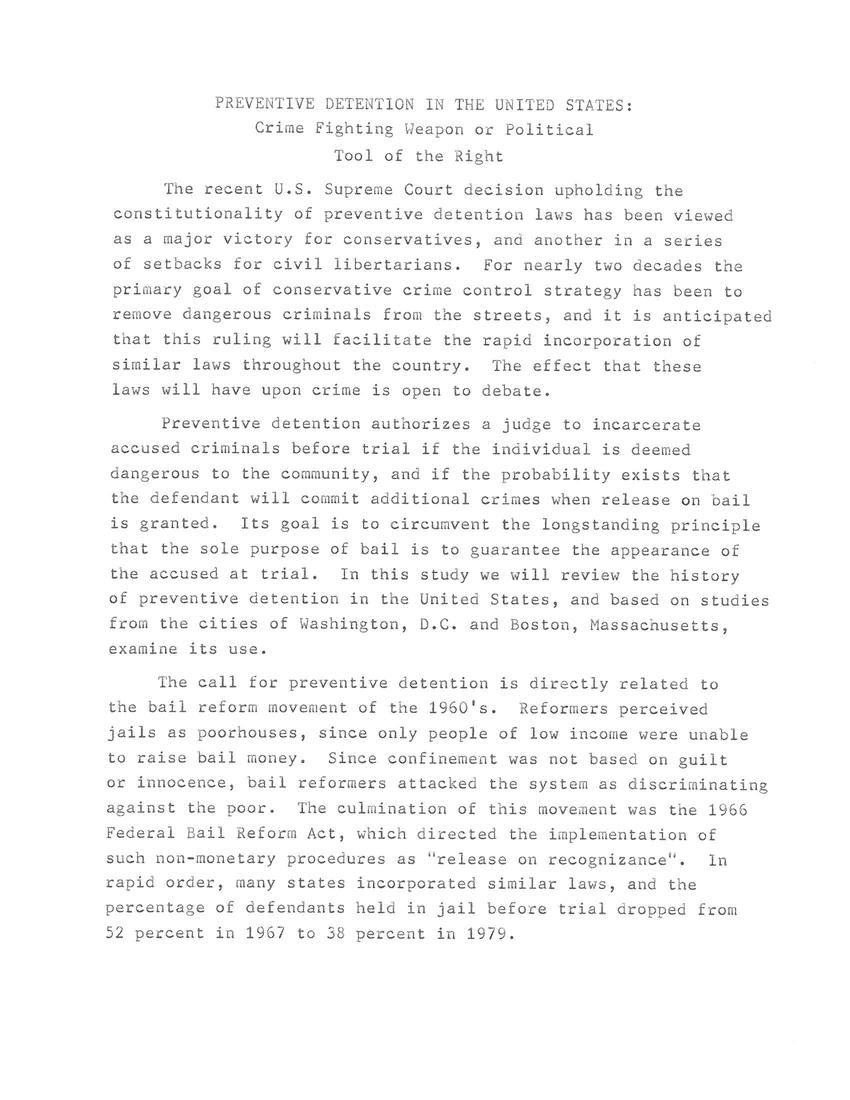
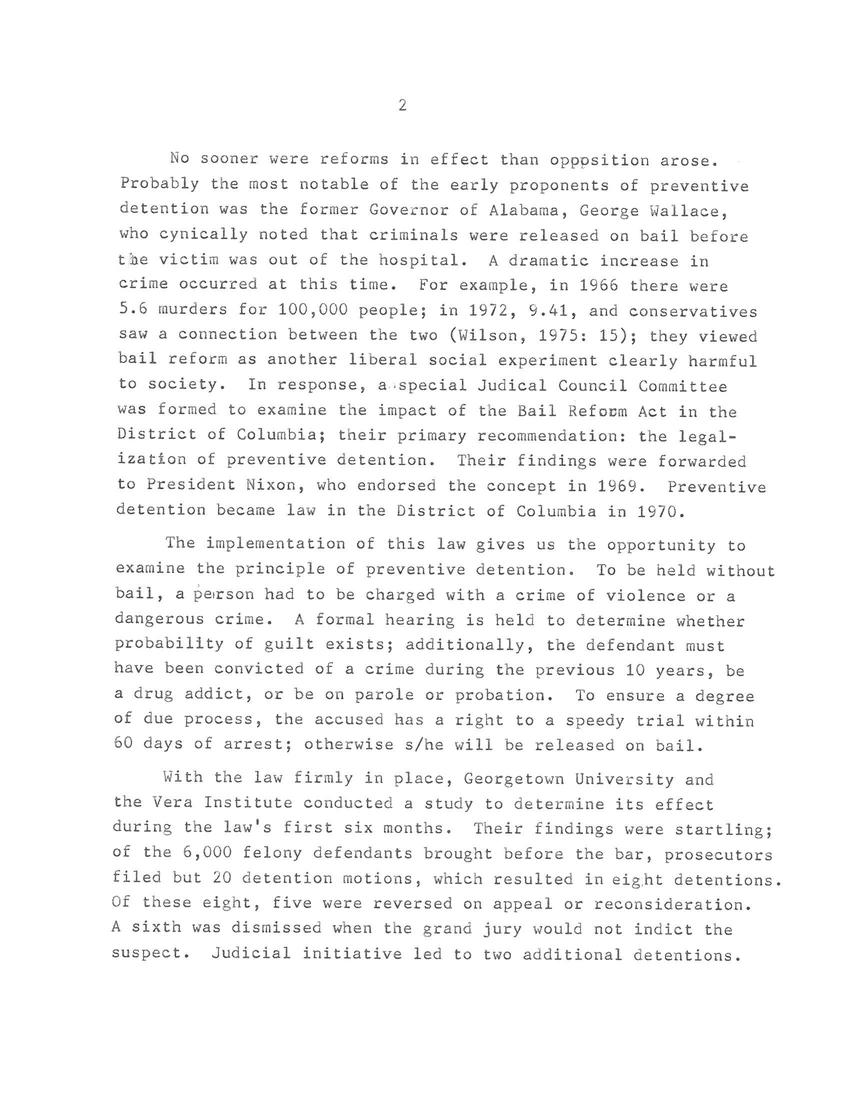
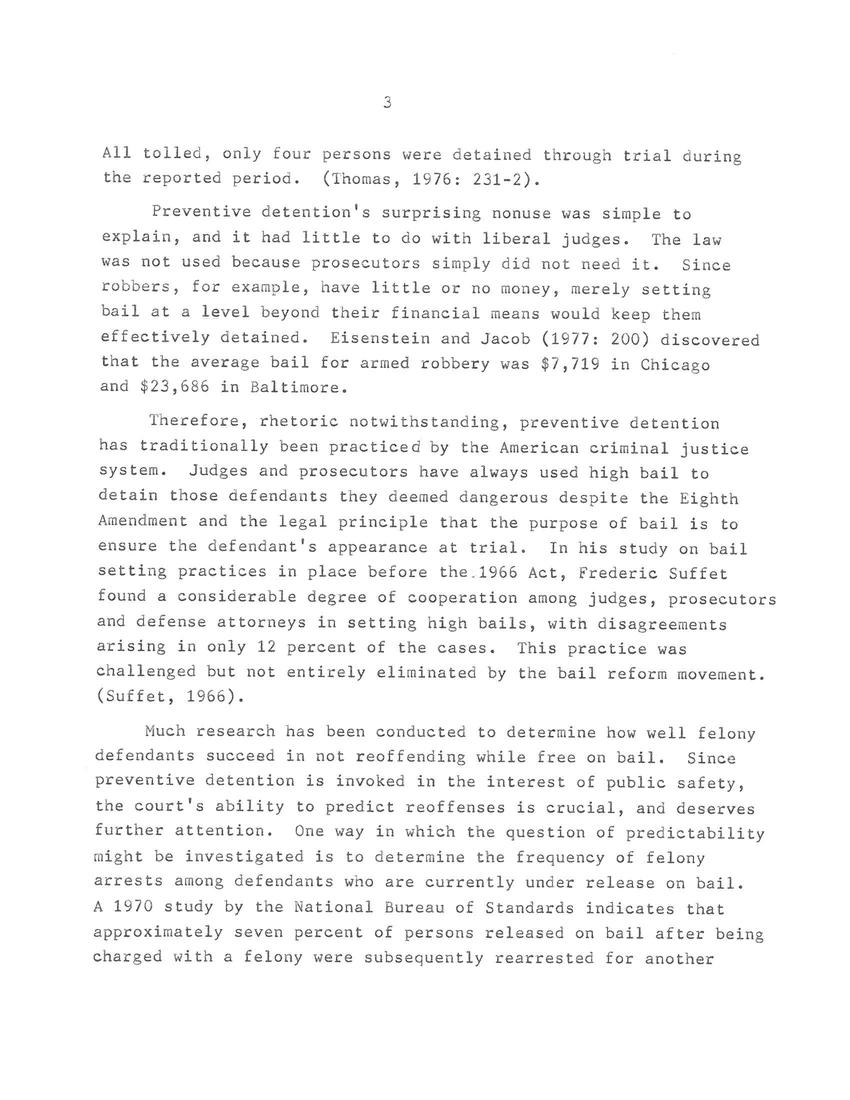
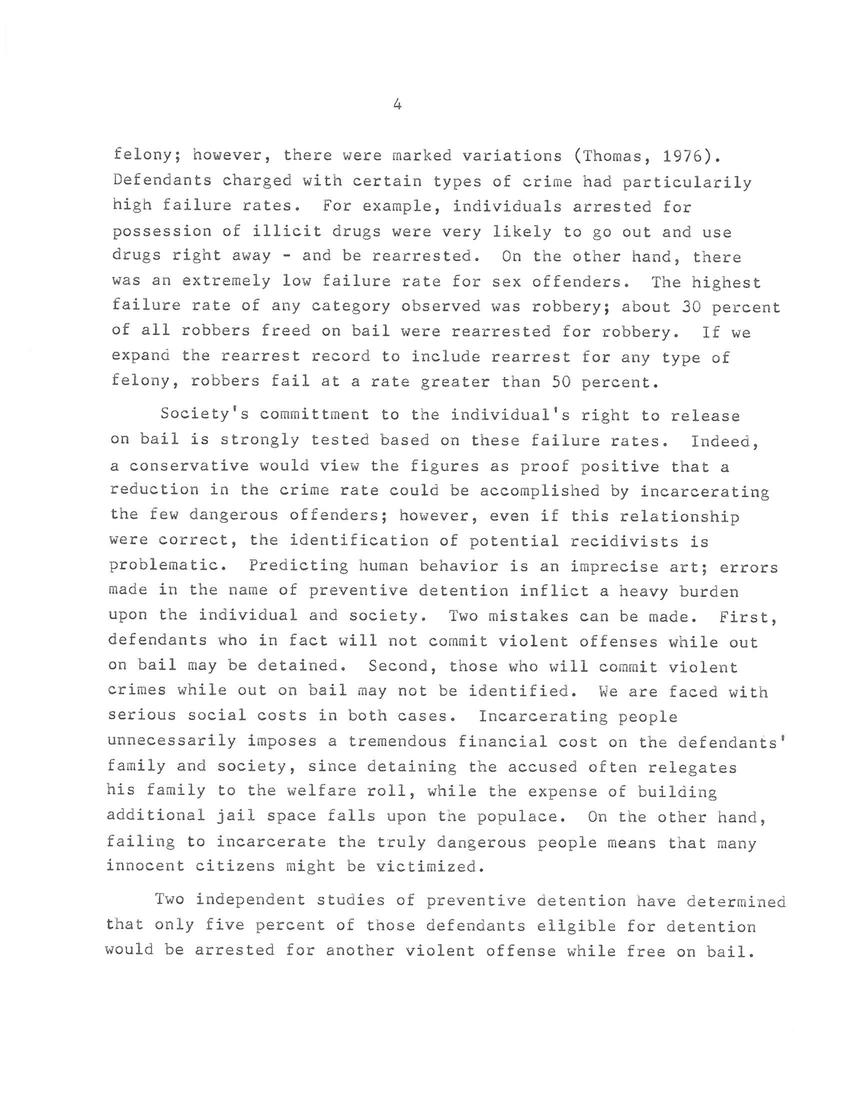
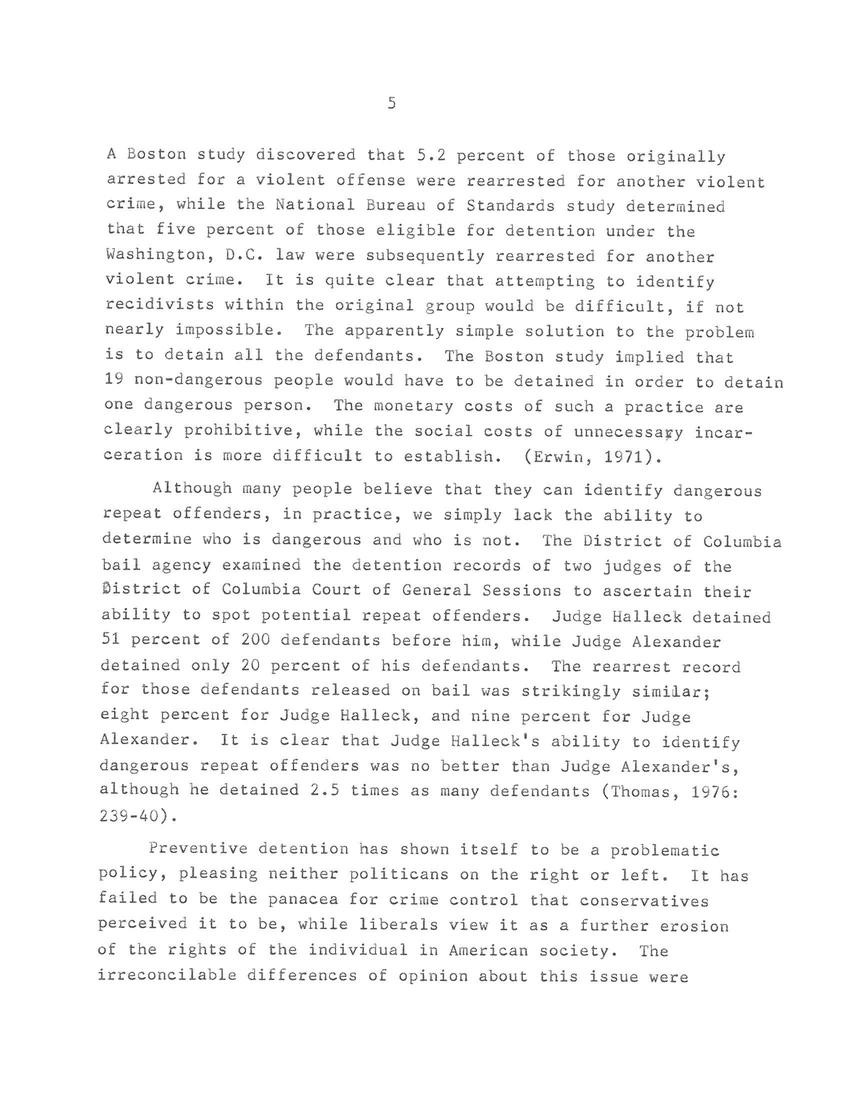


Replies